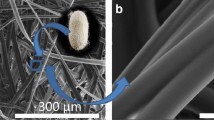Abstract
In this paper, we report a unique hierarchical core–shell polycaprolactone–polyaniline fiber with spinous surface structures, which is fabricated by direct in situ oxidative polymerization of aniline on the surface of porous electrospun PCL fibers. Due to the high surface area-to-volume ratio caused by the hierarchical structure, when utilized for ammonia gas sensing, the resulting core–shell fibers exhibit high sensitivity, which is far superior to that of the film or the smooth fiber counterparts. In addition, the sensor based on the current structure is extremely sensitive to the ammonia gas, which is evidenced by the fast response time (20 s) and the low detection limit (1 ppm). Moreover, the sensor not only shows good repeatability when repetitively exposing it to the ammonia gas but also exhibits good selectivity toward ammonia over other common volatile organic compounds. We thus believe the structure reported in the current study may have potential applications in the field of ammonia gas sensor.












Similar content being viewed by others
References
Yang XN, Loos J, Veenstra SC, Verhees WJH, Wienk MM, Kroon JM, Michels MAJ, Janssen RAJ (2005) Nanoscale morphology of high-performance polymer solar cells. Nano Lett 5:579–583
Chen J, Liu Y, Minett AI, Lynam C, Wang JZ, Wallace GG (2007) Flexible, aligned carbon nanotube/conducting polymer electrodes for a lithium-ion battery. Chem Mater 19:3595–3597
Bai H, Shi GQ (2007) Gas sensors based on conducting polymers. Sensors 7:267–307
Timmer B, Olthuis W, van den Berg A (2005) Ammonia sensors and their applications—a review. Sens Actuators B Chem 107:666–677
Chang QF, Zhao K, Chen X, Li MQ, Liu JH (2008) Preparation of gold/polyaniline/multiwall carbon nanotube nanocomposites and application in ammonia gas detection. J Mater Sci 43:5861–5866. doi:10.1007/s10853-008-2827-3
Nicolas-Debarnot D, Poncin-Epaillard F (2003) Polyaniline as a new sensitive layer for gas sensors. Anal Chim Acta 475:1–15
Huang JX, Kaner RB (2006) The intrinsic nanofibrillar morphology of polyaniline. Chem Commun 367–376
Huang JX, Virji S, Weiller BH, Kaner RB (2003) Polyaniline nanofibers: facile synthesis and chemical sensors. J Am Chem Soc 125:314–315
Wan PB, Wen XM, Sun CZ, Chandran BK, Zhang H, Sun XM, Chen XD (2015) Flexible transparent films based on nanocomposite networks of polyaniline and carbon nanotubes for high-performance gas sensing. Small 11:5409–5415
Yin ZG, Zheng QD (2012) Controlled synthesis and energy applications of one-dimensional conducting polymer nanostructures: an overview. Adv Energy Mater 2:179–218
Dong B, Gwee L, Salas-de la Cruz D, Winey KI, Elabd YA (2010) Super proton conductive high-purity nafion nanofibers. Nano Lett 10:3785–3790
Dong B, Smith ME, Wnek GE (2009) Encapsulation of multiple biological compounds within a single electrospun fiber. Small 5:1508–1512
Shadi L, Karimi M, Ramazani S, Entezami AA (2014) Preparation of electrospun nanofibers of star-shaped polycaprolactone and its blends with polyaniline. J Mater Sci 49:4844–4854. doi:10.1007/s10853-014-8185-4
Khattab TA, Abdelmoez S, Klapotke TM (2016) Electrospun nanofibers from a tricyanofuran-based molecular switch for colorimetric recognition of ammonia gas. Chem Eur J 22:4157–4163
Liu HQ, Kameoka J, Czaplewski DA, Craighead HG (2004) Polymeric nanowire chemical sensor. Nano Lett 4:671–675
Shenoy SL, Bates WD, Frisch HL, Wnek GE (2005) Role of chain entanglements on fiber formation during electrospinning of polymer solutions: good solvent, non-specific polymer-polymer interaction limit. Polymer 46:3372–3384
Liu LM, Liu M, Su YJ, Dong YG, Zhou W, Zhang LN, Zhang H, Dong B, Chi LF (2015) Tadpole-like artificial micromotor. Nanoscale 7:2276–2280
Liu LM, Dong YG, Sun YY, Liu M, Su YJ, Zhang H, Dong B (2016) Motion-based pH sensing using spindle-like micromotors. Nano Res 9:1310–1318
Bognitzki M, Czado W, Frese T, Schaper A, Hellwig M, Steinhart M, Greiner A, Wendorff JH (2001) Nanostructured fibers via electrospinning. Adv Mater 13:70–72
Lee EJ, Teng SH, Jang TS, Wang P, Yook SW, Kim HE, Koh YH (2010) Nanostructured poly(ε-caprolactone)–silica xerogel fibrous membrane for guided bone regeneration. Acta Biomater 6:3557–3565
Konwer S, Guha AK, Dolui SK (2013) Graphene oxide-filled conducting polyaniline composites as methanol-sensing materials. J Mater Sci 48:1729–1739. doi:10.1007/s10853-012-6931-z
Taddei P, Tinti A, Reggiani M, Fagnano C (2005) In vitro mineralization of bioresorbable poly(ε-caprolactone)/apatite composites for bone tissue engineering: a vibrational and thermal investigation. J Mol Struct 744–747:135–143
Guo YL, Wang T, Chen FH, Sun XM, Li XF, Yu ZZ, Wan PB, Chen XD (2016) Hierarchical graphene-polyaniline nanocomposite films for high-performance flexible electronic gas sensors. Nanoscale 8:12073–12080
Zhao J, Wu G, Hu Y, Liu Y, Tao X, Chen W (2015) A wearable and highly sensitive CO sensor with a macroscopic polyaniline nanofiber membrane. J Mater Chem A 3:24333–24337
Acknowledgements
This work was supported by the National Natural Science Foundation of China (Grant Nos. 21574094, 21304064), the Natural Science Foundation of Jiangsu Province (Grant Nos. BK20130292, BK20150314), Collaborative Innovation Center (CIC) of Suzhou Nano Science and Technology and a Project Funded by the Priority Academic Program Development of Jiangsu Higher Education Institutions (PAPD), the Fund for Excellent Creative Research Teams of Jiangsu Higher Education Institutions and the project-sponsored by SRF for ROCS, SEM.
Author information
Authors and Affiliations
Corresponding authors
Additional information
Wei Zhou and Yutong Guo have contributed equally to this work.
Rights and permissions
About this article
Cite this article
Zhou, W., Guo, Y., Zhang, H. et al. A highly sensitive ammonia sensor based on spinous core–shell PCL–PANI fibers. J Mater Sci 52, 6554–6566 (2017). https://doi.org/10.1007/s10853-017-0890-3
Received:
Accepted:
Published:
Issue Date:
DOI: https://doi.org/10.1007/s10853-017-0890-3




